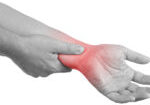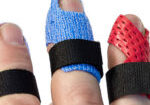Early Mobilization After Volar Locking Plate Osteosynthesis of Distal Radius Fractures in Older Patients: A Randomized Controlled Trial
Filed under Treatments
By: Rachel Reed
Sørensen, T. J., Ohrt-Nissen, S., Ardensø, K. V., Laier, G. H., & Mallet, S. K. (2020). Early Mobilization After Volar Locking Plate Osteosynthesis of Distal Radial Fractures in Older Patients-A Randomized Controlled Trial. The Journal of hand surgery, S0363-5023(20)30276-8. Advance online publication. https://doi.org/10.1016/j.jhsa.2020.05.009
The Skinny:
The purpose of this randomized controlled trial was to determine if early mobilization following open reduction internal fixation (ORIF) of distal radius fractures (DRFs) was more functionally beneficial for adults older than 50 years when compared to late mobilization. The authors hypothesized that patients would report higher positive outcomes with early mobilization; however, they found no significant differences between the two groups in ROM, grip strength, or DASH scores when assessed at 4 weeks, 3 months, 6 months, and 12 months after surgery.
In the Weeds:
This was a single-center randomized controlled trial (RCT) that took place over an 11-month period. The participants in this study received a volar locking plate (volar bearing plate) following a DRF (volar locking plate distal radius fracture). After surgery, they were randomly allocated to either the early mobilization (E-MOB) group or to the late mobilization (L-MOB) group. There was a total of 95 patients enrolled in this study; there were 47 patients in the E-MOB group and 48 in the L-MOB group.
The patients in the E-MOB group were provided with:
- A removable orthosis and daily exercises
- Non-weight-bearing exercises of the fingers and wrist from the first postoperative day
Patients in the L-MOB group were provided with:
- A dorsal plaster cast for 2 weeks
- After 2 weeks, a removable orthosis and exercises
The patients were assessed using range of motion (ROM), grip strength, and the Disabilities of the Arm, Shoulder, and Hand (DASH) questionnaire. Both groups improved when they were measured at 4 weeks, 3 months, 6 months, and 12 months after surgery. Additionally, there were no significant differences in DASH scores between the two groups at any point in time (P > .05).
Bringing it Home:
Because there were no significant differences in assessment measures between the two groups at any point in time, the authors concluded that early mobilization after surgery to treat distal radius fractures does not lead to improved patient-reported outcomes.
Rating:
3/5 – This study was interesting to read and had potential to inform practice guidelines. However, there were significant limitations to this study. The fact that the authors of this study defined late mobilization as immobilization lasting for only 2 weeks does not reflect the variation of late mobilization practices that are often put into practice by surgeons and doctors. Two weeks is still relatively early. In addition, the patient’s adherence to their home program was not monitored, which may have skewed data. It is also important to consider that the E-MOB group may not have had early mobilization exercises prescribed that were active enough to have a significant effect on their recovery (volar plate surgery recovery time is being reduced) when compared to the L-MOB group.
6 Comments
Leave a Comment
More To Read
Putting Occupation in Hand Therapy
It was early in my career, maybe a year out of school. I was working with a veteran physical therapist that had been practicing for thirty plus years. She was somewhat intimidating and one of those old school physical therapists that thrived on being aggressive. We were chatting about what areas of occupational hand therapy…
Read MoreA Fun Fact from a Hand Therapy Student
By: Ammie Ingwaldson Level 2 Fieldwork at a hand therapy clinic is a fast paced and continuous learning experience. The perfect example of this occurred last week while observing a therapist provide a client with their home CMC arthritis program. The therapist was educating the client on how to oppose their thumb to their small…
Read MoreManagement of a TFCC Injury in Hand Therapy
By: Taylor Volentine The wrist is composed of very complex joints that assists with movement in individuals of all ages and abilities. For instance, an active individual who participates in sports such as tennis, football, or gymnastics may increase the probability for wrist complications and injury (Morrison, 2019). Individuals with repetitive trauma from work or…
Read More5+ Common Mallet Finger Splints
Finger orthoses can be tough, and the mallet orthosis is no exception in hand therapy. The protocol for 15 degrees of DIP extension with mallet fingers is tricky to manage while making a common mallet finger splint. Small splints on little fingers are also tricky to get sized just right and with strapping in the…
Read MoreSign-up to Get Updates Straight to Your Inbox!
Sign up with us and we will send you regular blog posts on everything hand therapy, notices every time we upload new videos and tutorials, along with handout, protocols, and other useful information.







Early Mobilization definitely matters.
Getting the intrinsics to glide early makes life easier for the patient once they begin formal treatment
Great point.
Agree. I have seen cast put on improperly and there’s no intrinsic movement resulting in a lot of stiffness for the patient. I think it Has to be assessed on an individual basis. I think the bottom line is the patient should be seen by OT immediately to assess what they need to provide a good outcome
Yes, that is the ideal situation. For various reason this does not always happen!
What about starting at 4 weeks ? We get patients at 4 weeks often and I feel it’s a long rehab. Hand and wrist are stuff because they are told not to move until seeing a therapist .
Yes that is very late and does make for a long process.